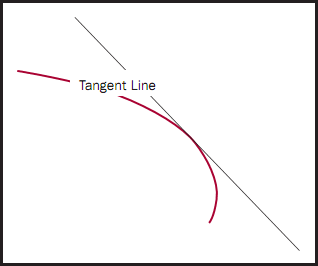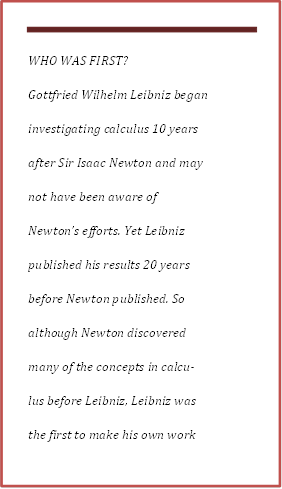


 تاريخ الرياضيات
تاريخ الرياضيات
 الرياضيات في الحضارات المختلفة
الرياضيات في الحضارات المختلفة 
 الرياضيات المتقطعة
الرياضيات المتقطعة
 الجبر
الجبر
 الهندسة
الهندسة 
 المعادلات التفاضلية و التكاملية
المعادلات التفاضلية و التكاملية 
 التحليل
التحليل
 علماء الرياضيات
علماء الرياضيات |
Read More
Date: 25-4-2018
Date: 16-8-2018
Date: 8-9-2019
|
As students first begin to study calculus in high school or college, many may be unsure about what calculus is. What are the fundamental concepts that underlie calculus? Who has been credited for the discovery of calculus and how is calculus used today?
What is Calculus?
Calculus was invented as a tool for solving problems. Prior to the development of calculus, there were a variety of different problems that could not be addressed using the mathematics that was available. For example, scientists did not know how to measure the speed of an object when that speed was changing over time. Also, a more effective method was desired for finding the area of a region that did not have straight edges. Geometry, algebra, and trigonometry, which were well understood, did not provide the necessary tools to adequately address these problems.
At the time in which calculus was developed, automobiles had not been invented. However, automobiles are an example of how calculus may be used to describe motion. When the driver pushes on the accelerator of a car, the speed of that car increases. The rate at which the car is moving, or the velocity, increases with respect to time. When the driver steps on the brakes, the speed of the car decreases. The velocity decreases with respect to time.
As a driver continues to press on the accelerator of a car, the velocity of that car continues to increase. “Acceleration” is a concept that is used to describe how velocity changes over time. Velocity and acceleration are measured using a fundamental concept of calculus that is called the derivative.

Derivatives can be used to describe the motion of many different objects. For example, derivatives have been used to describe the orbits of the planets and the descent of space shuttles. Derivatives are also used in a variety of different fields. Electrical engineers use derivatives to describe the change in current within an electric circuit. Economists use derivatives to describe the profits and losses of a given business.
The concept of a derivative is also useful for finding a tangent line to a given curve at a specific point. A tangent line is a straight line that touches a curve at only one point when restricted to a very small region. An example of a tangent line to a curve is shown in the figure. The straight line and the curve touch at only one point. The straight line is the tangent line to the curve at that point.
Tangent lines are useful tools for understanding the angle at which light passes through a lens. Derivatives and tangent lines were useful tools in the development and continued improvement of the telescope. Derivatives are also used today by optometrists or eye doctors to develop more effective methods for correcting vision. Physicists use tangent lines to describe the direction in which an object is traveling, and chemists use tangent lines to predict the outcomes of chemical reactions. These are only a few examples of the many uses of tangent lines in science, engineering, and medicine.
Derivatives along with the concept of a tangent line can be used to find the maximum or minimum value for a given situation. For example, a business person may wish to determine how to maximize profit and minimize expense. Astronomers also use derivatives and the concept of a tangent line to find the maximum or minimum distance of Earth from the Sun.
The derivative is closely related to another important concept in calculus, the integral. The integral, much like the derivative, has many applications. For example, physicists use the integral to describe the compression of a spring. Engineers use the integral to find the “center of mass” or the point at which an object balances. Mathematicians use the integral to find the areas of surfaces, the lengths of curves, and the volumes of solids.
The basic concepts that underlie the integral can be described using two other mathematical concepts that are important to the study of calculus— “area” and “limit.” Many students know that finding the area of a rectangle requires multiplying the base of the rectangle by the height of the rectangle. Finding the area of a shape that does not have all straight edges is more difficult.
The area between the curve and the x-axis is colored in (a) of the figure on the following page. One way to estimate the area of the portion of the figure that is colored is to divide the region into rectangles as is shown in (b). Some of the rectangles contain less area than is contained in the colored region. Some of the rectangles contain more area than is contained in the colored region. To estimate the area of the colored region, the area of the six rectangles can be added together.
If a better estimate is desired, the colored region can be divided into more rectangles with smaller bases, as shown in (c). The areas of these

rectangles can then be added together to acquire a better approximation to the area of the colored region.
If an even better estimate of the colored region is desired, it can be divided into even more rectangles with smaller bases. This process of dividing the colored region into smaller and smaller rectangles can be continued.
Eventually, the bases of the rectangles are so small that the lengths of these bases are getting close to zero.
The concept of allowing the bases of the rectangles to approach zero is based on the limit concept. The integral is a mathematically defined function that uses the limit concept to find the exact area beneath a curve by dividing the region into successively smaller rectangles and adding the areas of these rectangles. By extending the process described here to the study of three-dimensional objects, it becomes clear that the integral is also a useful tool for determining the volume of a three-dimensional object that does not have all straight edges.
An interesting relationship in calculus is that the derivative and the integral are inverse processes. Much like subtraction reverses addition, differentiation (finding the derivative) reverses integration. The reverse of this statement, integration reverses differentiation, is also true. This relationship between derivatives and integrals is referred to as the “Fundamental Theorem of Calculus.” The Fundamental Theorem of Calculus allows in-
?Who Invented Calculus
tegrals to be used in motion problems and derivatives to be used in area problems.
Pinpointing who invented calculus is a difficult task. The current content that comprises calculus has been the result of the efforts of numerous sci entists. These scientists have come from a variety of different scientific backgrounds and represent many nations and both genders. History, however, typically recognizes the contributions of two scientists as having laid the foundations for modern calculus: Gottfried Wilhelm Leibniz (1646–1716) and Sir Isaac Newton (1642–1727).
Leibniz was born in Leipzig, Germany, and had a Ph.D. in law from the University of Altdorf. He had no formal training in mathematics. Leibniz taught himself mathematics by reading papers and journals. Newton was born in Woolsthorpe, England. He received his master’s degree in mathematics from the University of Cambridge.
The question of who invented calculus was debated throughout Leibniz’s and Newton’s lives. Most scientists on the continent of Europe credited Leibniz as the inventor of calculus, whereas most scientists in England credited Newton as the inventor of calculus. History suggests that both of these men independently discovered the Fundamental Theorem of Calculus, which describes the relationship between derivatives and integrals.
The contributions of Leibniz and Newton have often been separated based on their area of concentration. Leibniz was primarily interested in examining methods for finding the area beneath a curve and extending these methods to the examination of volumes. This led him to detailed investigations of the integral concept.
Leibniz is also credited for creating a notation for the integral, ∫. The integral symbol looks like an elongated “S.” Because finding the area under a curve requires “summing” rectangles, Leibniz used the integral sign to indicate the summing process. Leibniz is also credited for developing a notation for finding a derivative. This notation is of the form dx/dy. Both of these symbols are still used in calculus today.
Newton was interested in the study of “fluxions.” Fluxions refers to methods that are used to describe how things change over time. As discussed earlier, the motion of an object often changes over time and can be described using derivatives. Today, the study of fluxions is referred to as the study of calculus. Newton is also credited with finding many different applications of calculus to the physical world.
It is important to note that the ideas of Leibniz and Newton had built upon the ideas of many other scientists, including Kepler, Galileo, Cavalieri, Fermat, Descartes, Torricelli, Barrow, Gregory, and Huygens. Also, calculus continued to advance due to the efforts of the scientists who followed. These individuals included the Bernoulli brothers, L’Hôpital, Euler, Lagrange, Cauchy, Cantor, and Peano. In fact, the current formulation of
the limit concept is credited to Louis Cauchy. Cauchy’s definition of the limit concept appeared in a textbook in 1821, almost 100 years after the deaths of Leibniz and Newton.
Who Uses Calculus Today?
Calculus is used in a broad range of fields for a variety of purposes. Advancements have been made and continue to be made in the fields of medicine, research, and education that are supported by the methods of calculus.
Everyone experiences the benefits of calculus in their daily lives. These benefits include the availability of television, the radio, the telephone, and the World Wide Web.
Calculus is also used in the design and construction of houses, buildings, bridges, and computers. A background in calculus is required in a number of different careers, including physics, chemistry, engineering, computer science, education, and business. Because calculus is important to so many different fields, it is considered to be an important subject of study for both high school and college students.
It is unlikely the Leibniz or Newton could have predicted the broad impact that their discovery would eventually have on the world around them.
______________________________________________________________________________________________
Reference
Boyer, Carl. A History of Mathematics. New York: John Wiley & Sons, 1991.
———. “The History of Calculus.” In Historical Topics for the Mathematics Classroom, 31st Yearbook, National Council of Teachers of Mathematics, 1969.
O’Connor, J. J., and E. F. Robertson. “The Rise of Calculus.” In MacTutor History of Mathematics Archive. St Andrews, Scotland: University of St Andrews, 1996. <http://
www~groupsdcs.st-and.ac.uk/~history/HistTopics/The_rise_of_calculus.html>.
Walker, Richard. “Highlights in the History of Calculus.” In Branches of Mathematics. Mansfield, PA: Mansfield University, 2000. <http://www.mnsfld.edu/~rwalker/
Calculus.html>.



|
|
|
|
التوتر والسرطان.. علماء يحذرون من "صلة خطيرة"
|
|
|
|
|
|
|
مرآة السيارة: مدى دقة عكسها للصورة الصحيحة
|
|
|
|
|
|
|
نحو شراكة وطنية متكاملة.. الأمين العام للعتبة الحسينية يبحث مع وكيل وزارة الخارجية آفاق التعاون المؤسسي
|
|
|